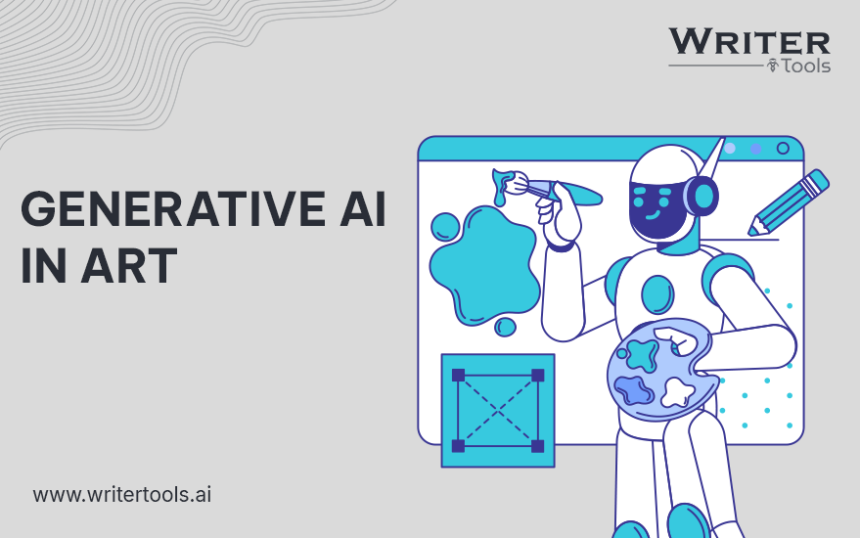In the ever-evolving world of art, technology has always played a pivotal role in pushing creative boundaries. From the invention of photography to the rise of digital tools like Photoshop, new technologies have continually reshaped how artists create and engage with their work. Today, we stand at the brink of a new revolution, one driven by generative AI—an exciting tool that is rapidly transforming the way art is made. But what exactly is generative AI, and why is it so impactful for the world of art?
What is Generative AI?
Generative AI refers to a branch of artificial intelligence that is capable of creating new, original content by learning patterns from existing data. Unlike traditional AI, which is typically designed to process, analyze, or classify information, generative AI can generate novel outputs—whether it’s images, music, text, or even videos—by drawing upon its vast understanding of existing works.
For example, generative AI meaning can be understood as AI that “creates” something rather than simply recognizing or categorizing it. These creations are often based on patterns, trends, or characteristics learned from large datasets. In the context of art, generative AI allows machines to produce pieces that mimic or even innovate upon human-created works.
Popular generative AI tools include:
- DALL·E: A model that generates images based on text prompts.
- DeepDream: Google’s neural network that creates surreal, dream-like images.
- Artbreeder: A platform where users can combine and evolve images using AI algorithms.
These tools allow artists to explore new creative territories and generate works that might not have been possible through traditional methods alone.
How Generative AI is Transforming the Art World
1. Expanding Creative Possibilities
Generative AI unlocks endless creative potential for artists. By using AI algorithms, artists can explore new visual styles, designs, and patterns that might not have been immediately obvious through conventional creative processes. For example, an artist can input a basic idea or concept, and the AI will generate a variety of interpretations, providing fresh sources of inspiration and new directions for further development.
Moreover, generative AI enables artists to blend different styles, merging techniques from diverse art movements, artists, or even cultures. This blending of styles is a unique strength of AI tools, offering a fresh lens through which artists can experiment and create.
2. AI as a Collaborator
Instead of replacing the artist, generative AI serves as a creative partner, enhancing the artistic process. Artists act as curators, using the AI as a tool to generate ideas, refine concepts, and explore creative solutions. The relationship between artist and machine is symbiotic—while the artist provides direction and input, the AI offers new perspectives, often surprising the artist with unexpected results.
This collaboration is akin to how artists have used other technological tools over time. Just as the camera revolutionized visual art and digital editing programs like Photoshop changed the landscape of design, generative AI offers new tools for creating in ways that weren’t possible before.
3. Exploring New Forms of Art
Generative AI is not limited to traditional visual arts like painting and sculpture. It is also giving rise to entirely new art forms, such as AI-generated music, poetry, and video art. Artists are using AI to create dynamic, evolving works that challenge conventional notions of authorship and originality.
For instance, AI can create interactive art installations where the artwork changes based on viewer interactions or generates music that adapts to the listener’s emotional state. These new forms of art blur the lines between the creator, the creation, and the audience, opening up exciting possibilities for immersive and participatory experiences.
4. Personalized and Custom Art
One of the most exciting aspects of generative AI is its ability to personalize and customize artwork for individual tastes. For instance, AI tools can generate unique portraits, landscapes, or designs based on personal preferences, allowing for bespoke creations that cater to the specific desires of the audience or the collector.
This opens new avenues for art commerce, where collectors can commission AI-generated pieces tailored to their individual tastes, or even create their own artwork by interacting with AI tools. The concept of personalized art is rapidly becoming a new frontier in the industry.
The Ethical and Philosophical Implications of AI in Art
As generative AI gains prominence in the art world, it also raises critical questions about the nature of art itself. For example:
- Who owns the rights to AI-generated art? If an AI creates a painting based on data it was trained on, does the credit go to the developer of the AI, the artist who guided the process, or the machine itself?
- What defines “authenticity” in art? If a piece is created by a machine rather than a human, does it still have value or meaning?
- Does AI perpetuate biases? If the AI is trained on biased datasets, the artwork it generates might reflect those biases. This raises concerns about representation, diversity, and fairness in the art world.
These ethical and philosophical questions will shape the future of generative AI in art, as both artists and consumers navigate the intersection of technology and creativity.
The Future of Generative AI in Art
The future of generative AI in art holds immense potential. As AI technology continues to advance, artists will gain more sophisticated tools for creating innovative works, possibly enabling machines to co-create with humans in ways that transcend our current understanding of art and creativity.
Ultimately, generative AI challenges traditional ideas of creativity and authorship. It questions the boundaries between human-made and machine-made art and invites us to reconsider what it means to be creative in the 21st century. As artists, technologists, and viewers continue to explore this new frontier, generative AI will undoubtedly redefine the possibilities of artistic expression.
Conclusion
Generative AI is more than just a technological advancement—it’s a creative tool that has the power to revolutionize the way we think about art. By enabling artists to generate unique, personalized, and innovative works, generative AI is opening up new possibilities for artistic expression and challenging traditional ideas about authorship, creativity, and the value of art.
As artists embrace generative AI and explore its potential, we can expect a future filled with unexpected collaborations between humans and machines, where the lines between artist, artwork, and technology blur, leading to a richer and more diverse creative landscape.
Whether you’re an artist looking to experiment with AI or simply an art lover curious about the intersection of technology and creativity, the world of generative AI is an exciting place to watch—and participate in—over the coming years.






